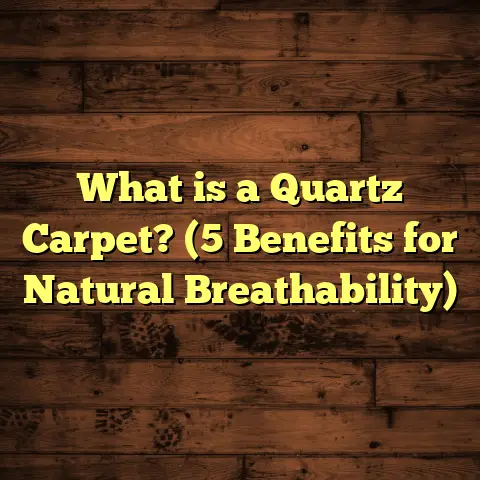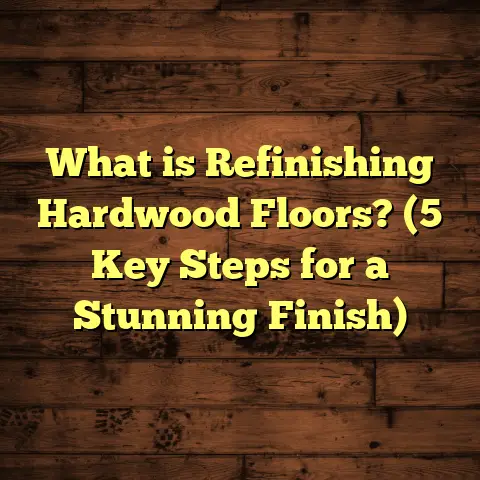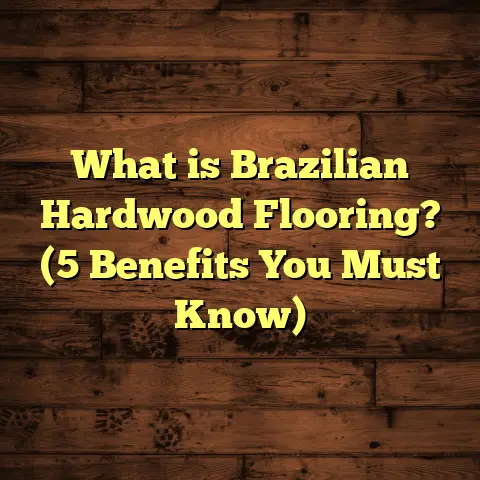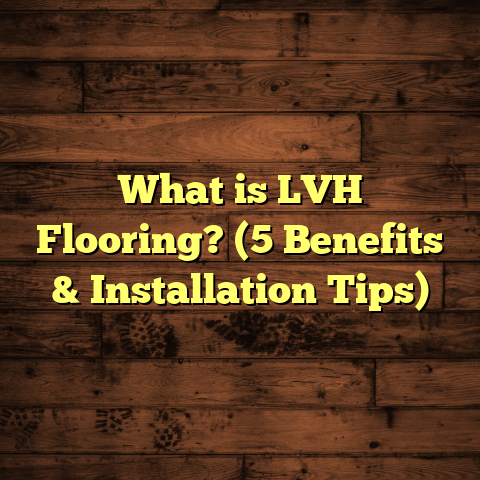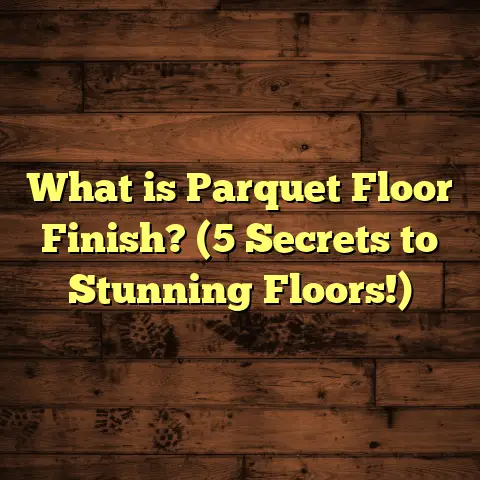What is LVP Flooring Worth? (5 Key Factors to Consider!)
Leaving a lasting impression with your flooring is more than just picking a surface to walk on. It’s about making a choice that fits your lifestyle, budget, and the look you want for your home or business. Over my many years working as a flooring contractor, I’ve noticed one question keeps popping up among clients and friends alike: “What is LVP flooring worth?” It’s simple on the surface but has many layers when you really start to think about it.
I want to take you through everything I know about LVP, or Luxury Vinyl Plank flooring, and why its worth depends on so many factors that go beyond price tags. I’ll share stories from my own hands-on experience, backed by data and insights from the flooring industry. Whether you’re considering installing LVP for the first time or wondering if it’s a smart investment, this article will help you understand what really matters.
What is LVP Flooring?
Let’s start by breaking down exactly what LVP is. Luxury Vinyl Plank flooring is a type of resilient flooring made to look like hardwood planks but crafted from vinyl. It’s designed to mimic the natural wood grain, texture, and color variations you’d find in real wood floors but with the benefits of vinyl’s water resistance and durability.
When I first began installing LVP about 12 years ago, it was mostly seen as an affordable alternative to hardwood that wasn’t quite as elegant. But since then, it has evolved tremendously. Manufacturers have improved both the look and performance, making it a popular choice for all kinds of spaces—from busy family homes to commercial offices.
How LVP is Made
Understanding some technical details can help you see why LVP holds its value well.
LVP is made up of several layers:
- Backing Layer: This gives the plank its stability and can sometimes include soundproofing properties.
- Core Layer: This is usually made of rigid vinyl or sometimes wood plastic composite (WPC) for strength.
- Design Layer: A high-resolution printed image that replicates wood grain or stone patterns.
- Wear Layer: A clear protective top coat that resists scratches, dents, and stains.
Over the years, I’ve learned that the thickness and quality of each layer play a big role in how long your floor will last and how well it performs under heavy use.
Why Choose LVP Over Other Flooring?
You might be wondering: “Why not just get hardwood or laminate?” The answer depends on your priorities.
- Water Resistance: Unlike hardwood, which can warp or swell with moisture, LVP handles spills, humidity, and even flooding better.
- Cost: Generally, LVP costs less per square foot than hardwood.
- Ease of Installation: Many LVP products use click-lock systems that make DIY installation possible.
- Maintenance: It requires no sanding or refinishing.
I’ve installed LVP in homes where hardwood wasn’t an option due to moisture issues—basements, kitchens, and bathrooms are prime examples.
1. Durability and Longevity: How Long Does LVP Last?
Durability plays a huge role in determining what LVP flooring is worth. When I recommend flooring to my clients, I always ask them about their lifestyle. Do they have kids? Pets? Busy households? High foot traffic? These questions impact which type of LVP makes the most sense.
The Wear Layer Is Everything
The wear layer is the transparent coating on top of the plank that protects against everyday damage. This layer’s thickness is measured in mils (thousandths of an inch).
- Residential Grade: Usually ranges from 6 to 12 mil.
- Commercial Grade: Can be 20 mil or thicker.
From my experience, floors with at least a 12 mil wear layer will hold up well in most homes. For commercial settings or very active households, I suggest 20 mil or more.
Here’s a quick example from a recent job:
A client with two energetic dogs wanted something that wouldn’t show scratches after a year. We installed LVP with a 20 mil wear layer. Two years later, their floor looked nearly new—no visible scratches or scuffs.
Resistance to Moisture and Stains
One of the biggest advantages I witnessed firsthand was how LVP handles moisture. Hardwood floors in kitchens or basements can warp or buckle if exposed to water. But LVP? It’s waterproof.
I installed LVP in a basement renovation where previous carpet had been ruined by flooding. The homeowner was thrilled that after a minor leak, the floor stayed intact without any damage.
How Long Does It Last?
Data from industry experts says:
- Average lifespan for quality residential LVP: 15-20 years.
- Lower-end products may last 5-10 years before needing replacement.
A study from the National Wood Flooring Association showed that homeowners who purchased mid-to-high-grade LVP reported satisfaction with longevity at over 85% after 10 years.
2. Installation Costs and Complexity: What Should You Expect?
I often get asked about pricing—how much does it cost to install LVP flooring? It depends on several factors.
Material Costs
First, let’s talk about materials:
- Entry-level LVP can cost as low as $2 per square foot.
- Mid-range options typically range from $3 to $5 per square foot.
- Premium or commercial-grade planks can reach $6-$8 per square foot.
The price difference usually reflects quality of materials and thickness of the wear layer.
Labor Costs
Labor varies by region and job complexity:
- Simple installation for click-lock plank floors averages around $2-$4 per square foot.
- Glue-down installations cost more because they require more prep work.
For example, in my area, I charge $3 per square foot for straightforward installations but increase that if the subfloor needs leveling or if there are lots of corners.
DIY vs Professional Installation
Many homeowners consider installing LVP themselves because it’s marketed as easy to install. While this can save money upfront, there are risks:
- Uneven subfloors can cause planks to separate or wear unevenly.
- Incorrect acclimation (letting planks adjust to room temperature and humidity) can cause buckling.
I’ve had clients call me months after trying to DIY because their floors started lifting or looked uneven. Sometimes paying a pro saves headaches later.
Using Tools Like FloorTally for Estimates
Tools like FloorTally can help you get accurate cost estimates based on your location, materials chosen, and labor rates. I used it recently for a kitchen remodel client in Chicago; it factored in waste percentages too — which is important to avoid buying too little or too much material.
3. Aesthetic Appeal: How Does It Look?
Style matters. You want a floor that complements your home’s design while reflecting your personality.
Realistic Wood Look
The realism of LVP has come leaps and bounds. When I started my career, vinyl floors looked obviously fake—glossy plastic with repetitive patterns.
Now manufacturers use high-definition printing technology with embossed textures that replicate natural wood grain beautifully.
A client recently told me she couldn’t believe her new LVP was not real wood until she tapped on it herself!
Variety of Designs
LVP comes in many styles:
- Traditional oak, maple, hickory
- Exotic woods like teak or mahogany
- Stone looks such as slate or marble
- Wide planks or narrow strips
I’ve installed wide plank LVP in modern homes for a sleek look and narrow planks in rustic cabins for charm.
Color Trends
Color trends shift over time. In recent years:
- Gray and whitewashed tones have grown popular for modern aesthetics.
- Warmer woods remain classic and timeless.
My advice? Pick colors that complement your existing décor but also won’t feel outdated quickly.
4. Maintenance Made Easy: How Much Work Is It?
One big selling point for me—and many clients—is how low-maintenance LVP is compared to hardwood or tile.
Cleaning Tips from My Experience
I tell people:
- Sweep or vacuum regularly to remove dirt/grit.
- Use damp mop with gentle cleaner (avoid harsh chemicals).
- Wipe spills immediately to prevent staining even though most spills don’t penetrate vinyl.
I once worked with a family who moved from hardwood to LVP because they got tired of refinishing every few years. They love that with LVP they just clean regularly and never worry about scratches or dents from their kids’ toys.
What To Avoid
Despite its toughness:
- Don’t drag heavy furniture across the floor without lifting.
- Avoid abrasive scrubbers.
Following these tips helps keep your floor looking fresh for years.
5. Impact on Home Value: Does LVP Add Resale Value?
If you’re thinking long-term, resale value is probably on your mind. Will installing LVP help sell your home faster or at a higher price?
What Real Estate Data Shows
Recent market studies indicate:
- Homes with updated flooring generally sell faster.
- Buyers appreciate floors that are both stylish and durable.
LVP’s water resistance makes it especially appealing in kitchens and bathrooms where buyers worry about future damage.
My Personal Cases
I helped several clients prepare homes for sale by recommending LVP upgrades instead of carpet or outdated tile. In one case, replacing old carpet with modern LVP led to multiple offers above asking price within days.
While hardwood may still command premium prices in luxury markets, good quality LVP offers great value for most buyers and neighborhoods.
Extra Factors That Affect What LVP Flooring Is Worth
Let me share some other elements that influence how valuable your LVP floor will be over time:
Brand Reputation
Not all LVP is created equal. Brands like Shaw, Armstrong, and Mohawk have solid reputations due to consistent quality control and warranties. Cheaper no-name options might save money initially but often disappoint after a few years.
Warranty Coverage
Check manufacturer warranties carefully:
- Most offer 10-30 year warranties covering wear layer and defects.
- Some warranties exclude damage from improper installation or heavy abuse.
A strong warranty can add peace of mind and protect your investment.
Environmental Factors
LVP is typically made from PVC vinyl which isn’t biodegradable but many brands now focus on low VOC emissions and eco-friendlier manufacturing processes. If sustainability matters to you, researching material sources can influence your choice.
Subfloor Condition
Remember: even the best LVP will fail prematurely if installed over an uneven or damaged subfloor. Always have your subfloor inspected before installation—it may require repairs or leveling which add costs but protect your floor’s longevity.
My Personal Story Installing LVP Flooring
Years ago, I installed LVP in an older home’s basement for a family who wanted a durable floor able to handle kids’ playtime plus occasional water leaks from storms.
The house had uneven concrete floors with cracks—all challenges we tackled before laying down high-end rigid core planks with a 20 mil wear layer.
Two seasons later, when heavy rains flooded part of the basement, the family was relieved their floor survived without warping or stains. They told me it changed how they used their space—now it was comfortable enough for movie nights and playdates without worry.
That project taught me how versatile and reliable good quality LVP can be under tough conditions—and why understanding what you’re paying for matters.
Breaking Down the Financials: Cost vs Value
Let’s crunch some numbers based on real projects I’ve done combined with industry averages.
| Item | Low-End Cost | Mid-Range Cost | High-End Cost |
|---|---|---|---|
| Material (per sq ft) | $2 | $4 | $7 |
| Labor (per sq ft) | $2 | $3 | $5 |
| Total Cost (1000 sq ft) | $4,000 | $7,000 | $12,000 |
| Expected Lifespan (years) | 5 – 10 | 10 – 15 | 15 – 20+ |
If you choose mid-range LVP at $7 per square foot all-in for your home’s main floor (1,000 sq ft), you’re spending about $7,000 total with an expected lifespan around 10-15 years depending on usage.
Compare this with hardwood floors costing upwards of $12-$15 per square foot plus refinishing costs every few years; you save on upfront costs and maintenance over time with LVP.
Common Questions About LVP Flooring Worth
Q: Can I install LVP myself?
A: Yes, if you have basic DIY skills and the right tools. Click-lock planks are easier than glue-down types. But be sure your subfloor is level and follow manufacturer instructions closely to avoid problems later.
Q: Is LVP good for bathrooms?
A: Absolutely! Its water resistance makes it ideal for bathrooms and kitchens where moisture is common.
Q: How do I clean my LVP floor?
A: Sweep regularly and mop lightly with pH-neutral cleaner. Avoid soaking floors excessively.
Q: Will pets damage my floor?
A: High-quality LVP with thicker wear layers resists scratches well—even from dogs’ nails—but no floor is completely scratch-proof. Use rugs in high-use areas for added protection.
Final Thoughts After Many Projects
Thinking about what LVP flooring is worth means thinking about more than just dollars per square foot. It’s about balancing cost with durability, appearance, maintenance needs, and how it fits your lifestyle long-term.
From my countless installs and client chats:
- Good quality LVP offers excellent value for families needing tough floors that look great.
- Installation costs vary but are generally reasonable.
- It holds up well under moisture and daily wear.
- Resale value improves when replacing outdated flooring with modern options like LVP.
If you want practical yet beautiful flooring without breaking the bank—or endless upkeep—LVP could be exactly what you need.
Feel free to reach out if you want advice tailored specifically to your project—I’m happy to share what I’ve learned firsthand!
This deep dive into Luxury Vinyl Plank flooring should give you everything you need to make an informed decision on whether it’s worth it for your home or business. The key is matching product quality with your unique needs so you get the best return on investment possible.
